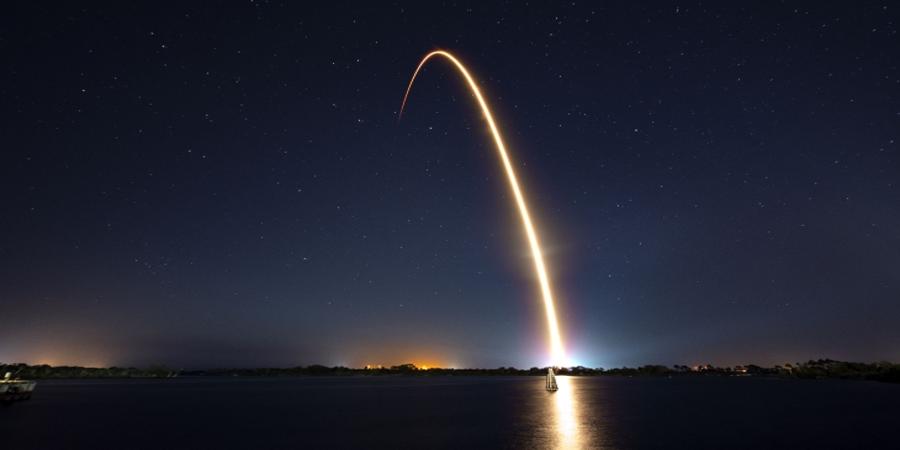Rockets are among the greatest feats in human engineering, but to Longshot Space CEO Mike Grace, they’re an “overly exquisite solution” to the problem of sending megatons of inert mass to space.
“You need something that is dumber and much cheaper, both to build and to operate,” he said in a recent interview.
Longshot’s answer is a kinetic launch system that will be capable of reaching hypersonic speeds and shooting projectiles to orbital velocities, for less than the cost of a Netflix subscription. It’s noticeably different than its competitors — specifically SpinLaunch, which is developing a spinning accelerator to shoot mass to orbit, and Stratolaunch, which uses a giant, specialized plane to release a hypersonic vehicle midair — in appearance and approach.
The biggest difference is that Longshot’s system is very, very horizontal. It is not technically a gun, as it doesn’t use an ignitor; instead, compressed gas squeezes a wedged projectile down a very long concrete tunnel that’s basically a vacuum chamber. The resultant speeds are extremely fast, and they increase in proportion to the size of the system.
That means a system capable of Mach 5 will be around 80 feet long; a Mach 10 system, the size of two or three football fields; and systems capable of getting to space, at Mach 25 to 30, on the order of multiple kilometers long.
It’s a staggering scale, but Longshot is aiming for a very lost cost to orbit — as low as $10 per kilogram to orbit (in comparison, the price tag of a Falcon 9 ride-share is $6,500 per kilogram). According to the company, its low prices are only achievable by keeping as much of the system on the ground as possible. Energy is stretched out over space and time; freed from the demands of vertical lift, such systems can suddenly be built out of concrete, rather than aluminum.
But there is no free lunch, especially in aerospace, and Longshot’s cheap prices will come with some major trade-offs. The first is the land footprint. Longshot’s system includes an on-site solar farm, in addition to the compressed gas pumps and tunnel, that will no doubt help keep costs low but add to the overall land-use requirements.
The other trade-off is noise. At such sizes, Longshot’s system will generate an extraordinary sonic boom. Given that the company will be able to reuse the system as quickly as it can draw a vacuum in the tunnel, that could mean many sonic booms per day. For these two reasons, the system will have to be sited somewhere very, very remote — think the Australian bush or the arid regions of Kenya.
“You would want to be somewhere where an atomic bomb could go off and nobody would notice,” Grace said.
These trade-offs could prove to be relatively trivial, should humanity finally consummate its desire to colonize the solar system. Grace pointed out that Hawaii imports 13 million tons of stuff, including food, gas to power cars, plastic products and more, for a population of around 1.4 million. An off-world colony — without the plentiful fresh water, atmosphere, soil, and everything else in our biosphere that aligns to make life possible — would need to import more. A lot more.
“Right now, that’s not really practical,” Grace said. “I don’t think it may ever be practical with rockets. So the question is, how do you drive the price of putting material in space through the floor?”
Elon Musk’s SpaceX is also looking to solve this problem, with its super-heavy Starship vehicle that will be capable of lifting upward of 250 metric tons to orbit in an expendable configuration. But Grace is not convinced that the economics of Starship will ever fully be able to compete with Longshot’s own system.
“I would expect [SpaceX] to spend somewhere between $5 [billion] and $30 billion on Starship before it’s good to go,” he said. “They’re going to need to get that money back. […] Some of Elon’s more hyperbolic comments about the price they’re going to be able to hit, maybe those are true, but it might be on a 40- or 50-year timescale. They might need to amortize those costs out for a very long time.”
That doesn’t mean Longshot would make Starship obsolete. The enormous amount of G pressure that would be generated by Longshot’s system is wholly unsuitable for the human body, so any person who wanted to go to space would be much better off on a rocket.
Longshot has gotten notably far with relatively little in funding. Since closing a $1.5 million pre-seed round last April, from investors that include Sam Altman, Draper VC and SpaceFund, and being awarded a direct-to-Phase II SBIR from the Air Force Research Laboratory, Longshot has built a test accelerator from its headquarters in Oakland, California, and achieved speeds up to Mach 2.2. Grace said he anticipates demonstrating speeds north of Mach 5 within a month.
Longshot’s demonstrator system. Image Credits: Longshot Space (opens in a new window)
Longshot’s demonstrator system. Image Credits: Longshot Space (opens in a new window)
In the short-term, Longshot wants to piggyback off the U.S. Department of Defense’s need for hypersonic capability, land some contracts, and use that revenue to essentially subsidize the development of a really big, really cheap launch system for space. On a longer time horizon, Grace said the real money will be made not from the launch system but by growing demand for services that Longshot offers in space.
“The key to being able to support that is having a system that can do it at extremely low cost,” he said. “You’ve got to get a system that is designed to be as dumb as hell.”
“Make it bigger. Don’t make it smarter. That’s expensive.”
Source @TechCrunch



